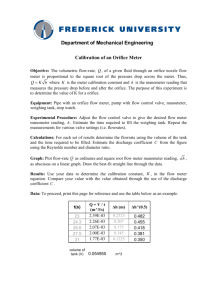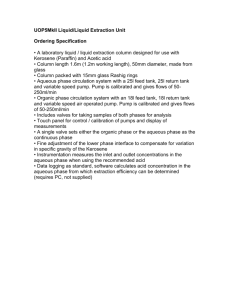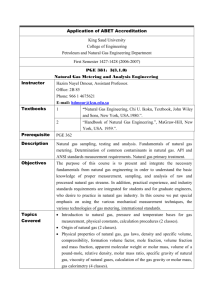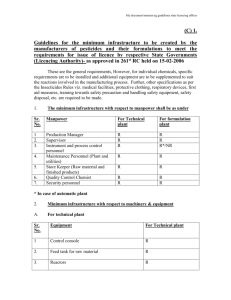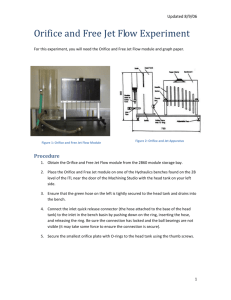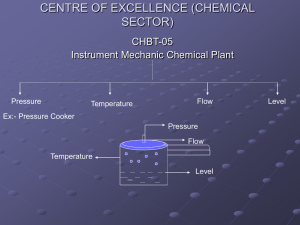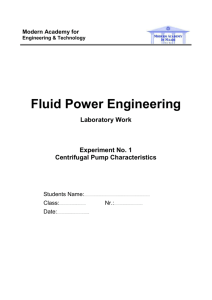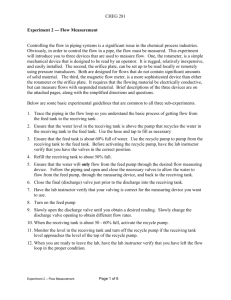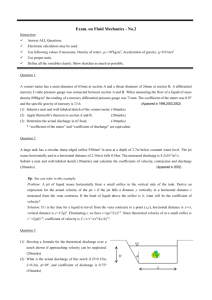Lab 4 - Wright State University
advertisement
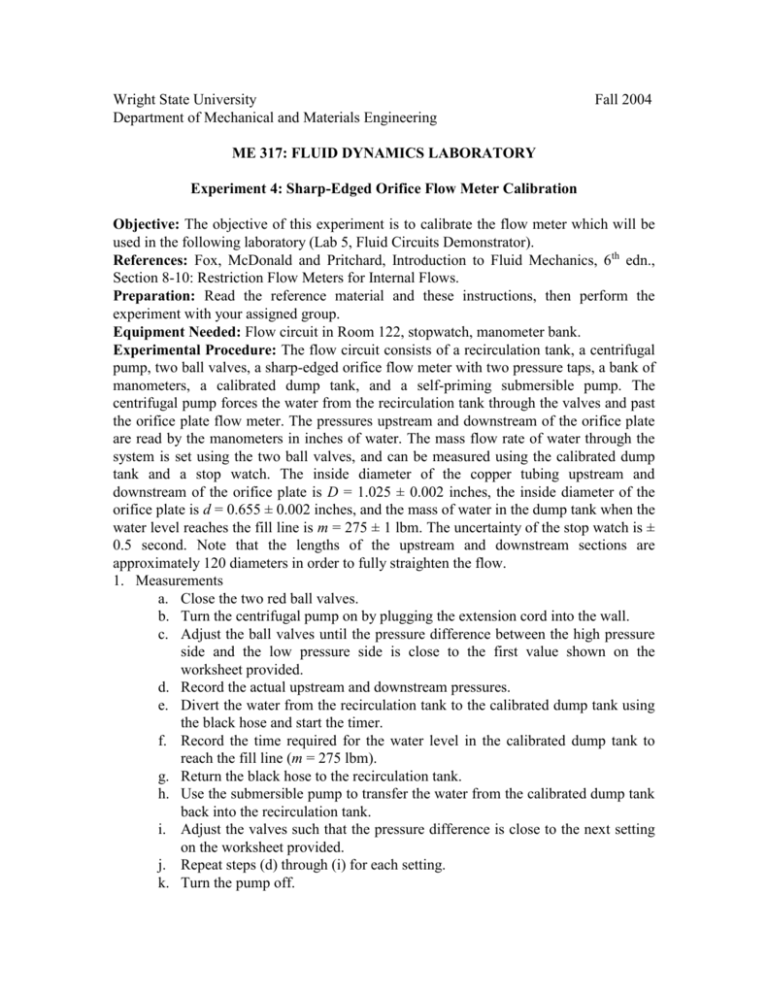
Wright State University Department of Mechanical and Materials Engineering Fall 2004 ME 317: FLUID DYNAMICS LABORATORY Experiment 4: Sharp-Edged Orifice Flow Meter Calibration Objective: The objective of this experiment is to calibrate the flow meter which will be used in the following laboratory (Lab 5, Fluid Circuits Demonstrator). References: Fox, McDonald and Pritchard, Introduction to Fluid Mechanics, 6th edn., Section 8-10: Restriction Flow Meters for Internal Flows. Preparation: Read the reference material and these instructions, then perform the experiment with your assigned group. Equipment Needed: Flow circuit in Room 122, stopwatch, manometer bank. Experimental Procedure: The flow circuit consists of a recirculation tank, a centrifugal pump, two ball valves, a sharp-edged orifice flow meter with two pressure taps, a bank of manometers, a calibrated dump tank, and a self-priming submersible pump. The centrifugal pump forces the water from the recirculation tank through the valves and past the orifice plate flow meter. The pressures upstream and downstream of the orifice plate are read by the manometers in inches of water. The mass flow rate of water through the system is set using the two ball valves, and can be measured using the calibrated dump tank and a stop watch. The inside diameter of the copper tubing upstream and downstream of the orifice plate is D = 1.025 ± 0.002 inches, the inside diameter of the orifice plate is d = 0.655 ± 0.002 inches, and the mass of water in the dump tank when the water level reaches the fill line is m = 275 ± 1 lbm. The uncertainty of the stop watch is ± 0.5 second. Note that the lengths of the upstream and downstream sections are approximately 120 diameters in order to fully straighten the flow. 1. Measurements a. Close the two red ball valves. b. Turn the centrifugal pump on by plugging the extension cord into the wall. c. Adjust the ball valves until the pressure difference between the high pressure side and the low pressure side is close to the first value shown on the worksheet provided. d. Record the actual upstream and downstream pressures. e. Divert the water from the recirculation tank to the calibrated dump tank using the black hose and start the timer. f. Record the time required for the water level in the calibrated dump tank to reach the fill line (m = 275 lbm). g. Return the black hose to the recirculation tank. h. Use the submersible pump to transfer the water from the calibrated dump tank back into the recirculation tank. i. Adjust the valves such that the pressure difference is close to the next setting on the worksheet provided. j. Repeat steps (d) through (i) for each setting. k. Turn the pump off. Wright State University Department of Mechanical and Materials Engineering Fall 2004 ME 317: FLUID DYNAMICS LABORATORY Experiment 4: Sharp-Edged Orifice Flow Meter Calibration 2. Data Reduction a. The laboratory teaching assistant will obtain a copy of the experimental data taken by each lab section, which will be forwarded in electronic form to me. Download the data from all of the lab sections for data reduction at my website: http://www.cs.wright.edu/people/faculty/sthomas/me317.html b. Create an Excel spreadsheet to calculate following: the experimentally determined mass flow rate, the ideal mass flow rate, the discharge coefficient, the Reynolds number, and the predicted mass flow rate. Also use this spreadsheet to calculate the experimental uncertainty in the mass flow rate. c. Create a graph by plotting the discharge coefficient C on the y-axis versus the Reynolds number of the flow based on the pipe diameter Re ρV1 D / μ 4m actual / πμD on the x-axis, where V1 is the fluid velocity in the pipe upstream from the orifice plate. d. Create a graph by plotting both the experimental mass flow rate and the predicted mass flow rate on the y-axis versus the orifice plate pressure difference on the x-axis. For the experimental data, use a scattered plot with no lines and error bars. Experimental Uncertainty: Use the methods of Appendix F to estimate the uncertainties in the calculated results for the experimental mass flow rate. Report: Prepare a brief report in the usual format. The above-mentioned Excel spreadsheet and the two graphs are to be included. Derive the following equation for the ideal mass flow rate using Bernoulli’s equation and the continuity equation: 2 g h1 h2 m ideal d 2 4 d 4 1 D The discharge coefficient is defined as the ratio of the actual mass flow rate to the ideal mass flow rate: m C actual m ideal The predicted mass flow rate is given in terms of the average discharge coefficient as follows: predicted C m ideal m Answer the following questions: 1. What trend do you see in the discharge coefficient? What is the benefit of using the discharge coefficient? 2. Is the mass flow rate predicted well by the analysis? Why or why not? Wright State University Department of Mechanical and Materials Engineering Fall 2004 ME 317: FLUID DYNAMICS LABORATORY Experiment 4: Sharp-Edged Orifice Flow Meter Calibration Data Sheet Approximate Pupstream Pdownstream Pressure Time (min/sec) (inches H2O) (inches H2O) Drop Setting 2.5 / 5.0 / 7.5 / 10.0 / 12.5 / 15.0 / 20.0 / 25.0 / 30.0 / 35.0 / 40.0 / 45.0 /
